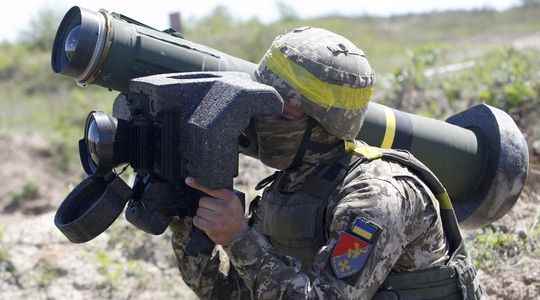Every day since February 24, hundreds of thousands of munitions have been used in Ukraine. But will the deluge of fire, both on the Russian and Ukrainian side, be able to continue for a long time? After two and a half months of conflict, the ammunition reserves of the two armies are dwindling. Visiting a factory of the Lockheed Martin group in Alabama on Tuesday – which, among other things, manufactures the famous Javelin missile launchers exported en masse to kyiv -, Joe Biden insisted on the importance of continuing arms deliveries to allow the Ukraine “to defend itself” against Russian aggression. The stocks of this portable anti-tank system, which has become one of the great symbols of Ukrainian resistance, are however beginning to run out.
In March, kyiv said it needed 500 of these missiles a day. Problem: the annual production capacities hardly reach 6000 pieces per year. Otherwise, the US military has been forced to draw on its own stocks to meet the increased demand from Ukrainian forces. “The U.S. military has probably sent about a third of its Javelin anti-tank missiles to Ukraine,” Democratic Senator Richard Blumenthal told a Senate Armed Services Committee meeting in late April. these weapons would require 32 months”.
According to the White House, the United States has already sent 5,000, plus 500 more from other Western countries. “It will become difficult to maintain this level of exports insofar as our own stocks are dwindling sharply, concedes Mark Cancian, senior adviser to the Center for Strategic and International Studies (CSIS), a Washington think tank. However, the The United States is still able to provide other anti-tank weapons, such as the BGM-71 TOW missiles, which unlike the Javelins are not infantry-portable, but are still very effective.”
Ukrainian artillery running out
However, this is not the only supply difficulty kyiv is facing. The case of Soviet-designed ammunition, still widely used by its Ukrainian forces, appears to be the other big black spot. At the current rate of fighting, they “will be very quickly exhausted”, underlined at the end of April with the New York Times Colorado Democratic Rep. Jason Crow. If those used for light weapons, type AK47, are less threatened with shortage, because of their abundance on the world markets, the case of artillery is more worrying, notes Mark Cancian.
“The problem for the Ukrainian forces is that they cannot obtain the shells they need from Russia or China. These are the two main producers of artillery ammunition to standard Soviets”, explains the former colonel of the Marines. Massive Russian strikes against Ukrainian arms factories have further limited the alternatives. “The former Eastern Bloc countries such as Germany, Poland or the Czech Republic had reserves dating from the Soviet era, but they are reaching the end of what they could provide”, adds General Dominique Trinquand, military expert and former head of the French mission to the UN.
Faced with this situation, Joe Biden announced on April 28 that he wanted to allocate aid of 33 billion dollars to Ukraine, including 20 billion intended for the supply of armaments. “If Ukraine switches to Western systems, it will be easier for us to provide it with the ammunition it needs, notes Ben Hodges, former commander of American forces in Europe. But this operation will necessarily take time.” In recent weeks, announcements of deliveries of heavy weapons to NATO standards have multiplied. On April 22, Emmanuel Macron announced the shipment to Ukraine of 12 Caesar guns. Four days later, Berlin authorized the delivery to kyiv of about fifty anti-aircraft tanks of the “Gepard” type, while the Netherlands confirmed the supply of howitzers of the Panzerhaubitze 2000 type.
Shortage of Russian missiles
Ukraine is not alone in facing a shortage of certain ammunition. The US Department of Defense said on May 2 that Russia had fired as many as 2,125 missiles since the start of the invasion of Ukraine. “It is estimated that Moscow has used around 70% of its long-range precision missiles, notes Ben Hodges. The difficulty is that the Russians can no longer manufacture new ones because they need components from the Western countries, which are unavailable due to sanctions against them.”
A few days after the start of the Russian invasion, the United States had indeed banned the export of sensitive technologies to Russia in the defense, aviation and navy sectors. A scarcity of its precision ammunition which has a very concrete impact for the Russian army on the ground. “The Russian air force will have to use more unguided bombs, which are imprecise and force the pilots to put themselves in a position of vulnerability by flying much lower”, explains Vincent Tourret, researcher at the Foundation for Strategic Research (FRS ). A situation putting them de facto within range of Ukrainian anti-aircraft systems.
What hinder a little more a Russian aviation which is already struggling to impose itself in the air. “Russia has larger ammunition reserves than Ukraine, but kyiv has the advantage of being able to be supplied by Westerners,” summarizes Mark Cancian. “If the nature of their difficulty is different, the problem of the exhaustion of ammunition will be in both cases decisive for the continuation of the conflict.”
